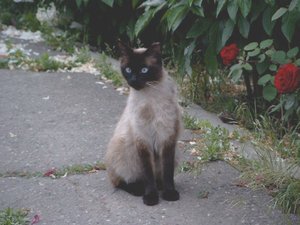 |
 |

CAT BREEDS A-Z Siamese
As a result of thousands
of generations of selective breeding and the pressures of competition
there are now actually two subbreeds of Siamese – the modern
show Siamese, and the traditional or "apple-headed" Siamese.
Modern show Siamese have been bred to be extremely elongated, with
bodies All Siamese have a creamy base coat with coloured "points" on their muzzles, ears, paws and lower legs, and tails. The darker Siamese have a darkening of their back and hindquarters as well. Originally Siamese were all seal-pointed, but now they have been bred in all of the standard cat colours including red, lilac, blue, chocolate, tabby and "torty" or tortoise-shell. In the United Kingdom, all pointed Siamese-style cats are considered to be part of the Siamese breed. In the United States, however, only four colorations are considered Siamese: seal point, blue point, chocolate point, and lilac point. Oriental cats with colorpoints in colors or patterns aside from these four are considered Colorpoint Shorthairs in the American cat fancy. The dark coloration on the coat is produced by an enzyme that is heat-sensitive; it fails to work at normal body temperatures, but becomes active in cooler areas of the skin (such as the ears, legs, tail and face (which is cooled by the passage of air through the sinuses). All Siamese kittens, although pure cream or white at birth, develop visible points in the first few months of life in colder parts of their body. By the time the kitten is four weeks old the points should be clearly distinguishable enough to recognise which colour they will be. Many Siamese are cross-eyed to compensate for the abnormal uncrossed wiring of the optic chiasm, which is produced by the same albino allele that produces coloured points. Siamese cats crossed with
Burmese cats are known as "Tonkinese".Siamese
cats crossed with Bengal cats are known as Serengetis. The Serengeti
is a new breed of spotted cat. |
Please don't forget to leave your paws in the Purrfect guestbook!!!
Top Of Page | Back | About Us | Home | Choosing A Cat | Behaviour | Care | Health | Breeds | Facts | Humour | Poems Glossary | My Cat Pictures | Books | Links | Bookmark | Contact Us | Terms Of Use | Disclaimer | Privacy Policy
Copyright © 2006 ThePurrfectPaws
All Rights Reserved.
Feline Illustrations by Abida
Fahim
 sacred
temple cats of Siam (hence their name). The breed was first seen
outside their Asian home in 1884, when the British Counsul-General
in Bangkok, Mr. Owen Gould, brought a pair of the cats back to Britain
for his sister, Mrs. Veley (who went on to be co-founder of the
Siamese Cat Club in 1901). The cats were shown at the Crystal Palace
in 1885, and the following year another pair (with kittens) were
imported by a Mrs. Vyvyan and her sister. A small number of cats
were brought in over the next few years, and together these formed
the base breeding pool for entire breed in Britain.
sacred
temple cats of Siam (hence their name). The breed was first seen
outside their Asian home in 1884, when the British Counsul-General
in Bangkok, Mr. Owen Gould, brought a pair of the cats back to Britain
for his sister, Mrs. Veley (who went on to be co-founder of the
Siamese Cat Club in 1901). The cats were shown at the Crystal Palace
in 1885, and the following year another pair (with kittens) were
imported by a Mrs. Vyvyan and her sister. A small number of cats
were brought in over the next few years, and together these formed
the base breeding pool for entire breed in Britain. slender to the point of emaciation, and a Y-shaped head with an
extremely long muzzle and extra-large "batwing" ears.
The traditional Siamese are much sturdier, with a round head and
ears more in proportion to their size. Siamese cats often have a
kink in their tails, because the original breeders saw that as a
unique feature of the breed. In recent years the kinked tail has
been considered a "flaw" and breeders have largely eradicated
it from the Show Siamese. Both breeds of Siamese have almond-shaped
eyes and like all Oriental cats they are extremely talkative and
demanding of attention. They often will engage themselves in crazy
antics to get the attention of their people, and often attach themselves
to one human in a household. As they are "wired for sound",
they can meow loud enough to compete with fire and rescue equipment.
Siamese cats are generally believed to be highly intelligent (by
cat standards), and their behaviour usually reflects this.
slender to the point of emaciation, and a Y-shaped head with an
extremely long muzzle and extra-large "batwing" ears.
The traditional Siamese are much sturdier, with a round head and
ears more in proportion to their size. Siamese cats often have a
kink in their tails, because the original breeders saw that as a
unique feature of the breed. In recent years the kinked tail has
been considered a "flaw" and breeders have largely eradicated
it from the Show Siamese. Both breeds of Siamese have almond-shaped
eyes and like all Oriental cats they are extremely talkative and
demanding of attention. They often will engage themselves in crazy
antics to get the attention of their people, and often attach themselves
to one human in a household. As they are "wired for sound",
they can meow loud enough to compete with fire and rescue equipment.
Siamese cats are generally believed to be highly intelligent (by
cat standards), and their behaviour usually reflects this.